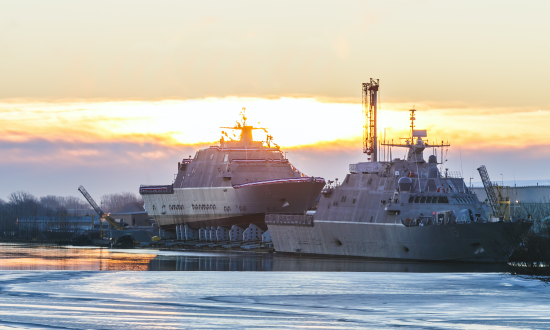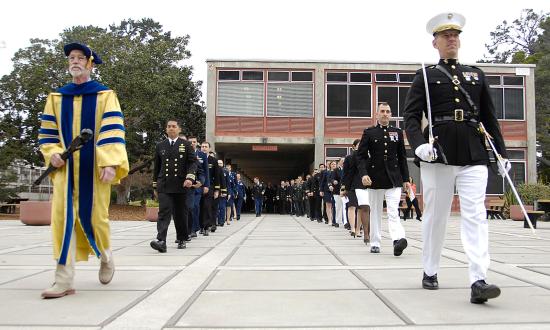Every four years, the Pentagon experiences a dramatic leadership turnover, as civilian appointees resign to return to civilian life or move to more senior jobs for an administration’s second term. This places significant pressure on the new team in the Department of Defense (DoD) to form quickly to meet the persistent national security challenges. We must realize that the world broadly is getting more complex, and with it so is the national security environment that U.S. defense leaders must address—and de-risk. How this environment will evolve is unpredictable, but I contend we should expect a future in which the most aggressive of our global adversaries, namely, China, Russia, Iran, and North Korea will continue to push against U.S. influence and the global promotion of liberty, free commerce, and human rights to advance their interests and to fulfill their own national visions.
There is no more important institution to secure the nation and push back on this advance than the U.S. Navy–Marine Corps team. Having had the opportunity to lead these amazing organizations as both Acting Secretary of the Navy and Under Secretary of the Navy and Chief Management Officer, I offer three priorities for consideration by the next Secretary: Gray Hulls, Gray Matter, and Gray Zones.
Priority 1: GRAY HULLS
The United States needs a well-articulated maritime and ship construction strategy that defines a newer, larger, more innovative, more cyber-focused, and more integrated Navy and Marine Corps force structure. This strategy will require the broad support of the citizens our sailors and Marines are asked to protect. It must be reliably funded by their representatives in Congress and faithfully implemented by the executive branch, without annual budget endgames that sacrifice ships and capability on the altar of other priorities.
The force structure must exceed 355 traditional “gray hull” ships and be more agile and distributed, at a lower cost per hull, and incorporate unmanned systems and robust cyber defenses. Funding must be stable and predictable, so the Navy and its industrial partners can plan effectively, drive down costs, and build reliable and secure supply chains to support the new force.
The future integrated naval force structure must be accomplished within a strategically relevant timeframe of ten years or less, and its mix of ships and the integration of new technologies must be continually iterated.
Developing this strategy and structure should be the top priority of the new Secretary of the Navy. The choice cannot be between a larger fleet or one with advanced capabilities. The nation needs both. Therefore, the new Secretary must fight for a bigger share of the defense budget for the Department of the Navy. No services are better suited to address the security challenges of the future than the Navy and Marine Corps. Combined, they provide the nation with continual global presence and the ability to deploy and react at a moment’s notice with light and adaptable forces. This capability must be protected and enhanced, particularly as the nation faces growing threats to its commercial interests on and beneath the seas and expanded military competition in the maritime, cyber, and space domains that threatens freedom of navigation in the Pacific, North Atlantic, and Arctic.
In fall 2019, work began on the concept of a truly integrated Navy and Marine Corps force structure that would more directly inform the shipbuilding plan. As Under Secretary of the Navy, I wrote a memo for the Defense Secretary’s signature directing the Commandant of the Marine Corps and the Chief of Naval Operations to build the shipbuilding plan together for the first time. The 2019 Integrated Naval Force Structure Assessment was the first product developed through this process. Unfortunately, the effort was derailed when the Secretary directed a Navy force study to be led by the Office of the Secretary of Defense. This took another nine months to complete, with results not substantially dissimilar to what the INSFA had developed long before.
The next Secretary must reassert the Department of the Navy’s ownership of and intellectual influence on the force structure plan. The shipbuilding strategy, and the numbers of ships in each class it recommends, should be less definitive in terms of final numbers, and instead suggest ranges within each category that will provide the basis for iteration informed by modeling, experimentation, and technological innovations. The Deputy Chief of Naval Operations for Warfighting Requirements and Capabilities and the Marine Corps Deputy Commandant for Combat Development and Integration—the team that developed the first INSFA—should form a permanent office, jointly led, to coordinate this effort under the direction of the Chief of Naval Operations, Commandant of the Marine Corps, and Secretary of the Navy.
This group should report findings quarterly, aligned with key budget decision-making milestones. In addition, it should collaborate with industry to help better determine industrial feasibility, as well as with a select group of congressional staff for the purposes of transparency and building advocacy.
These steps will not guarantee a perfect force structure; however, they will allow for the structure to adjust and adapt more rapidly as technology and the national security environment evolve unpredictably over time. The Secretary of the Navy must take ownership of the development and execution of the plans this process produces. He or she must be the biggest advocate inside and outside the Pentagon for the future naval force structure and the shipbuilding strategy it directs. The Secretary of the Navy must know it cold—and believe in it.
Priority 2: GRAY MATTER
The landmark 2018 Education for Seapower (E4S) report recognized that the intellectual capability of the Navy and Marine Corps team and a lifelong passion for continuous learning are the foundation of any credible deterrent to war. In the two years after the report’s release, the Department of the Navy moved quickly to introduce sweeping changes in the prioritization, integration, and resourcing of naval education—including hiring the first Chief Learning Officer (CLO), with a direct reporting relationship to the Secretary of Navy. The CLO was given the authority to unite the Naval Education Enterprise, to better take advantage of intellectual capital and budget resources and to move it into the future. A new Warfighter Development Directorate (N7) was created to work closely with the Marine Corps Deputy Commandant for Combat Development and Integration to ensure educational strategies were aligned with the Marine Corps and with long-term strategies for integrated Navy-Marine Corps operations.
Perhaps the most significant initiative was the establishment of the Naval Community College (NCC), which was met with great enthusiasm from enlisted Sailors and Marines. The NCC was created to provide opportunities for continuous education through a series of partnerships with community colleges, colleges, and universities across the country, to provide online and in-person course offerings that could lead to associates degrees and beyond. Such opportunities tend to elude Sailors and Marines because of their work and deployment schedules, but they are critical for their professional development—both during their naval service and when they return to civilian life.
Despite all its obvious benefits, the E4S initiative has lost momentum. The first CLO resigned abruptly, and the Navy has not moved with urgency to fill the position. Further, the Secretary of Navy moved the CLO position to a subordinate role under the Assistant Secretary of the Navy for Manpower and Reserve Affairs—relegating it to the “functional” rather than “enterprise/strategic” level. This sent a terrible signal about the strategic value of education for the Department’s people.
The next Secretary of the Navy should read, own, and implement the Education for Seapower report and Naval Education Strategy 2020. To deter future conflicts and to win those it cannot avoid, the Navy–Marine Corps team must operate at its full intellectual potential. The only way to reach that level is through education, creating an ever-increasing level of intellectual agility. In an increasingly complex and unpredictable world, Sailors and Marines need to know how to think, not merely what to think. If this is not a priority for the Secretary of the Navy, it won’t be for anyone else in the Department.
The next Secretary should hire a new, innovative CLO from outside the bureaucracy to reignite the momentum of E4S. The CLO should be a direct report to the Secretary of the Navy as originally conceived. In addition, this new CLO must commit to serve for at least three years, to provide leadership continuity.
Then, the Naval Community College, as well as the four academic institutions that make up the crux of the Department’s educational system—the Naval War College, Naval Postgraduate School, Marine Corps University, and U.S. Naval Academy—must be fully funded and incentivized to work more closely together in the development and delivery of their respective curricula. These curricula need to place a greater emphasis on history, geopolitics, and strategy, leadership and ethics, and the new realms of cyber and space-based security studies. All this will give our Navy–Marine Corps team a better understanding of the world and the adversaries who inhabit it and create adaptable leaders prepared for times of rapid change and unpredictability.
Priority 3: GRAY ZONES
Here, the term “gray zones” refers to the many things that happen behind the scenes, deep within the Department’s bureaucracy, that can either enable or inhibit the execution of the naval mission. These gray zones encompass a wide range of business and human capital management challenges that must evolve to meet emerging requirements. The new Secretary should prioritize three in particular: digital transformation, financial management and audit, and supply chain modernization.
Digital Transformation
Of the three priorities, this is perhaps the most urgent. Society is advancing in the digital era at a rapid and accelerating pace, and the Department of the Navy is not keeping up. Basic business and communication systems and platforms in the Navy are a decade or more behind the times. Cybersecurity is also woefully inadequate and has created vulnerabilities that can be exploited by adversaries.
The Cyber Security Strategic Study commissioned by former Secretary of the Navy Richard Spencer identified a litany of deficiencies in this regard. The findings were not controversial, or debatable, so the new Secretary must continue the efforts to address these deficiencies. He or she must elevate the digital and information management function to the secretary level—making the Chief Information Officer (CIO) a direct report—and actively support the CIO to remove barriers to change and fully fund this mission.
The highest priority should be modernizing the Department’s network and office suite software. Again, results cannot be achieved overnight. Elevation of the CIO function is a good first step, but the implementation of strategy must be sustained, which will require the full engagement of the Secretary of the Navy. He or she must provide top cover for the CIO with respect to delegated authority and budget control over all IT spending.
Financial Management and Audit
After years of earnest efforts, the Department is making progress in improving financial accountability, but problems persist. Audit and improved financial management are not solely the responsibility of the Department’s financial management professionals. They are enterprise-level responsibilities. The Secretary should continue to hold the Under Secretary of the Navy, not just the Department’s Chief Financial Officer and Comptroller, responsible for progress in this area and take an active interest in the audit findings.
The Secretary should require the Under Secretary to continue to develop mechanisms to hold commanders responsible for key areas such as inventory management. The Department’s inability to account for its assets must be corrected, but this will happen only if the Secretary gets engaged in solving the problem.
Supply Chain Modernization
The supply chain our Sailors and Marines rely on for all manner of parts and materials is a complex mix of organizations that seems to have been elegantly designed to avoid accountability for failures. The Secretary should immediately direct a study to examine how to consolidate the leadership and organization of the current structure into something that more closely resembles a world-class commercial supply chain operation.
In late 2020, we assembled a group of the Navy’s most senior supply chain leaders to do just that. We introduced them to civilian supply chain leaders from some of the top industrial enterprises in the nation. These civilian professionals were astounded that the Department of the Navy did not have a single leader at the head of—and accountable for—the supply and logistics chain. This must be corrected and that leader must be tasked with developing a vision and strategy for a new, more accountable, and more efficient supply chain organization for the future of the integrated naval service.
All Ahead Flank
The next Secretary of the Navy will face an overwhelming number of long-term challenges during his or her tenure. A focus on these three “gray areas” will help that tenure be distinguished by lasting accomplishments. Nonetheless, time will always be the Secretary’s number 1 enemy—and the greatest ally of those who resist change. He or she must not be satisfied with phrases such as “This is just the way we do things in the Navy”—a phrase I heard many times as justification for accepting the status quo. On the first day in office, the Secretary must be prepared to challenge those “ways” and to set sail, at flank speed, into the gray.









